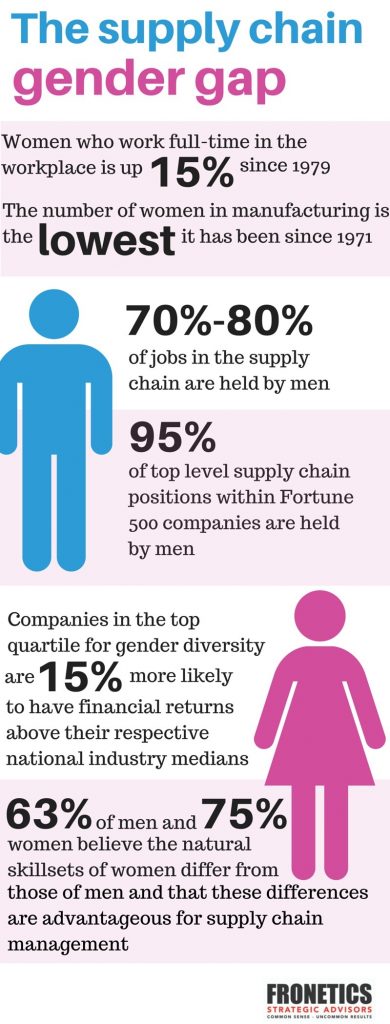
The number of women who work full-time in the workforce is up 15% since 1979. In the manufacturing sector, the story is very different. The number of men working in the manufacturing sector has increased, while the number of women working in the sector has declined. The number of women in the sector now stands at the lowest it has been since 1971.
Looking more broadly at the supply chain industry, it is clear that there is a significant gender gap. Between 70% and 80% of positions within the supply chain industry are held by men and 95% of top level supply chain positions within Fortune 500 companies are held by men. By comparison, men hold 85% of all executive officer positions within Fortune 500 companies.
The dearth of women working, at all levels, in the supply chain is not because women do not have the skillset and ability to succeed within the industry. Women are as capable as men when it comes to working within the supply chain industry. Indeed, it has been put forth that women are better suited for roles in supply chain management than men. Research conducted by SCM World found that the majority of men (63%) and women (75%) believe that the natural skillsets of women differ from those of men and that these differences are advantageous for supply chain management. Similarly, new research by McKinsey & Company found that companies in the top quartile for gender diversity are 15%more likely to have financial returns above their respective national industry medians.
The talent gap; an opportunity
According to Supply Chain Insights 60% of companies within the supply chain industry have job openings and 51% of companies are seeing an increase in turnover of supply chain leaders. Looking ahead, there are an estimated 1.4 million new supply chain workers needed by 2018 and the Bureau of Labor and Statistics predicts that the number of logistics jobs is expected to grow by 22 percent by 2022 – nearly double the rate of other professions. The supply chain talent gap arguably presents an opportunity to increase the number of women in positions throughout the supply chain and close the gender gap. The big question is how.
Addressing the gender gap
Here are 4 ways the supply chain industry can address the gender gap:
1. Increase visibility and tackle the image problem
93% of most companies’ supply chain is invisible. This statistic could also be used to reflect the number of people who know what the supply chain industry is; few people outside of the industry know what the supply chain is and what career opportunities there are. This needs to change.
To attract new talent the industry needs to make people aware of the supply chain – what it is, the integral role it plays in business, and the various opportunities there are within the industry.
2. Rethink talent acquisition and promotion
Within the supply chain industry the typical path up the corporate ladder has started out on the shop floor. If the industry is going to attract women and new talent companies need to look not only beyond their four walls, but also outside of the industry itself. When it comes to talent acquisition smart companies focus on the qualities of the individual and what they can bring to the table.
3. Move from talk to action
Battalia Winston’s Susan Medina and Peter Gomez point out that: companies without a proactive diversity-building strategy will fall victim to common-pitfalls and will fall flat.
“It’s important to acknowledge that diversity building is a proven growth strategy, not a superficial endeavor. But paying lip service to diversity and inclusion without a proactive strategy will lead to failure. Organizations need to prioritize, collaborate, and think long term.”
4. Take control
Women tend only to apply for jobs that they feel they are a 100% match; men do so even when they meet no more than 60% of the requirements. Similarly, men tend to be promoted more often than women simply because they speak up and ask for a promotion.
Women need to take responsibility for themselves and for their own careers. Women need to apply for jobs with confidence, even when they don’t have 100% of the requirements. They also need to speak up and ask for a promotion.
Kevin O’Marah, Chief Content Officer at SCM World, sums up the issue of the supply chain gender gap nicely: “Women in supply chain are too few, and their path to the top is at least partially blocked. Yet we all seem to think they bring something to the party that will make it better. The time to break this problem down is now.”

